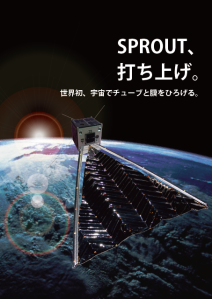SPROUT, a 20 x 20 x 22 cm amateur radio nano-satellite with a mass of 7.1 kg, launched successfully with the L-band (1236.5 MHz/1257.5 MHz/1278.5 MHz) Synthetic Aperture Radar (SAR) satellite ALOS-2 on May 24, 2014 at 0305 UT. SPROUT is now in a 654 km, 97.9 degree inclination Sun Synchronous Orbit (SSO).
SPROUT (Space Research On Unique Technology) was built by students from Nihon University and its objectives are:
1. Operation of satellite by radio amateurs.
A FM Digitalker will enable the satellite to speak to amateurs around the world.
The Voice Message Box will record transmissions from radio amateurs and play them back.
Pre-loaded images from the Message Gallery can be transmitted using Slow Scan TV (SSTV).
Pictures of the Earth can be transmitted by SSTV and radio amateurs can receive it using free software such as MMSSTV. As part of the Earth mapping project the team ask radio amateurs to contribute pictures they have received from the satellite for display on the SPROUT website.
The satellite also has a packet radio Digipeater and Text Message Box function.
 2. Demonstration of the deployment of the combined membrane structure and verification of the design method of the structure SPROUT has a triangular membrane supported by two tubes like framework. They are folded and stored in the satellite before the launch. After the launch, the nitrogen gas is injected into the tubes in space, and they extend, so that the membrane deploys (called “combined membrane structure”).
2. Demonstration of the deployment of the combined membrane structure and verification of the design method of the structure SPROUT has a triangular membrane supported by two tubes like framework. They are folded and stored in the satellite before the launch. After the launch, the nitrogen gas is injected into the tubes in space, and they extend, so that the membrane deploys (called “combined membrane structure”).
3. Demonstration of attitude determination and control of a nanosatellite using the sun sensors, gyros, geomagnetic sensor and magnetic torquers.
It carries two UHF/VHF radio systems – one for Telemetry, Tracking & Control (TTC) using CW, 1200 bps AFSK and 9600 bps GMSK AX.25 packet and one for amateur operations using 1200 bps AFSK AX.25 packet.
SPROUT plans to launch from the Tanegashima Space Center into a 654 km Sun Synchronous Orbit (SSO) on May 24, 2014.
 Callsign: JQ1ZJQ
Callsign: JQ1ZJQ
Size: 214x210x220 mm
Weight: 7.1 kg
Mode: 1200bps AFSK, 9600bps GMSK
CW downlink 437.525 MHz
FM packet downlink 437.525 MHz
Digi-peater uplink 437.600 MHz
Digi-talker downlink 437.600 MHz
SSTV downlink 437.600 MHz
SPROUT English website http://sat.aero.cst.nihon-u.ac.jp/sprout-e/
SPROUT Japanese website http://sat.aero.cst.nihon-u.ac.jp/sprout/
Nihon-Univ. Miyazaki Laboratory on Facebook
https://www.facebook.com/pages/Nihon-Univ-Miyazaki-Laboratory/406566642818860
Telemetry Software http://sat.aero.cst.nihon-u.ac.jp/sprout-e/2-Software-e.html
Telemetry format http://sat.aero.cst.nihon-u.ac.jp/sprout-e/2-Formats%20of%20telemetry-e.html
Keplerian elements (TLEs) from SPROUT launch data page
http://sat.aero.cst.nihon-u.ac.jp/sprout-e/2-Launch%20data-e.html
SPROUT 1 00000U 14001A 14144.15446759 .00000000 00000-0 00000-0 0 0013 2 00000 97.8740 241.6718 0035980 58.6810 194.6458 14.85960816 14
After launch TLE’s from the North American Aerospace Defence Command (NORAD) should also be available at http://celestrak.com/NORAD/elements/tle-new.txt
Adding new satellites to SatPC32, Gpredict and Nova
https://amsat-uk.org/2013/11/23/adding-new-satellites-to-satpc32/
Free Slow Scan TV (SSTV) software MMSSTV http://hamsoft.ca/pages/mmsstv.php
The JE9PEL website has information on other satellites on this launch
http://www.ne.jp/asahi/hamradio/je9pel/jaxalos2.htm
Read the Overview of the L-band SAR Onboard ALOS-2 here.



You must be logged in to post a comment.